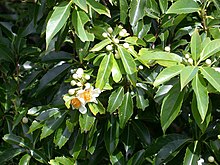Schima
| Schima | ||||||||||||
|---|---|---|---|---|---|---|---|---|---|---|---|---|

Schima wallichii |
||||||||||||
| Systematics | ||||||||||||
|
||||||||||||
| Scientific name | ||||||||||||
| Schima | ||||||||||||
| flower |
Schima is a genus of plants fromthe tea shrub family (Theaceae).
description
Schima are evergreen small to medium-sized trees, their leaves are spiral, leathery and either entire or notched. Characteristically, the trees reach heights of up to 30 meters and diameters of up to 76 cm.
The flowers are often found in clusters at the end of the branches. The flower stalks are short. There are two (rarely more) prophylls , these are obsolete and sit on the upper third of the pedicel.
The five sepals are almost the same shape, the five petals are weakly fused at the base, the outermost leaf envelops the others as a bud. The stamens are attached to the petals at their base.
The ovary is five to siebenfächrig, with two to six ovules per carpel , the stylus is unbranched. The fruit is an approximately round capsule , the calyx remains on it at the fruit base. The seeds are kidney-shaped, narrowly winged and flat. The embryo is curved, the cotyledons are thin, of uneven shape and flat or folded lengthways. The endosperm is thin.
distribution
The genus is restricted to Southeast Asia. It is distributed from India and China southwards to New Guinea . The plant is native to Brunei , China , India , Indonesia , Laos , Malaysia , Myanmar , Nepal , Papua New Guinea , the Philippines , Thailand and Vietnam .
ecology
The demands on soil and climate that Schima makes are relatively low. It prefers dry soils, but also grows in river and swamp regions. Schima is not very particular about the texture of the floor. The tolerable annual temperatures are between 0 and 45 ° C. Mostly Schima occurs in mountain forests up to 2400 meters above sea level and in primary forests in the lowlands. Sometimes it can also be observed in secondary forests, in bushes and grasslands and even in flooded areas. The demands on light are in the middle range.
Systematics
The genus consists of only 1 species and up to 30 subspecies, including:
- Schima superba Gardner & Champ. (Syn .: Schima wallichii var. Superba (Gardner & Champ.) Bloemb. , Schima wallichii subsp. Liukiuensis (Nakai) Bloemb. ): It occurs in China, on the Ryūkyū Islands and in Taiwan.
-
Schima wallichii (DC.) Korth. : It occurs in India, Nepal, Bhutan, Bangladesh, in Indochina, Indonesia, Malaysia, in the Philippines and in China. It has the chromosome number 2n = 36. With the subspecies:
- Schima wallichii subsp. wallichii
- Schima wallichii subsp. crenata (Korth.) Bloemb. (Syn .: Schima crenata Korth. )
Wood
Names
Like the genera Adinandra and Gordonia , Schima is traded under the international trade name Samak. Another well-known Malaysian trade name is Puspa.
Macroscopic features
The transition from sapwood to heartwood is not clearly visible. The color of the wood varies between red-brown, gray-brown and pink-brown. The bulk density varies between 0.53 and 0.64 g / cm 3 with a wood moisture content of 15%. It is a medium-weight hardwood. Zones of growth are not clearly visible.
Microscopic features
The wood is porous. There are ladder-shaped vascular openings. The vessels are exclusively solitary. At the ends of the vessels, spiral-shaped vessel thickenings can be seen. Thin-walled thylles are present. The vascular pits are ladder-shaped and arranged opposite one another. The intersection field pits have greatly reduced courtyards. The axial parenchyma is paratracheal and diffuse. It's not banded. The rays are usually 2-3 rows. Crystals are present.
Mechanical properties
| Parameter | value | unit |
|---|---|---|
| Bulk density | 590 | kg / m 3 |
| Compressive strength parallel to the fiber | 43.4 | N / mm 2 |
| modulus of elasticity | 12300 | N / mm 2 |
Use of wood
Schima wood is not very durable. The heartwood is also difficult to impregnate. It is used, among other things, for medium-heavy constructions without the effects of weather, floor coverings, cladding, door and window frames, toys, etc. It is also used to make plywood and also as firewood.
proof
- PF Stevens, S. Dressler, AL Weitzman: Theaceae. In: Klaus Kubitzki (Ed.): The Families and Genera of Vascular Plants . Volume 6: Flowering Plants, Dicotyledons: Celastrales, Oxalidales, Rosales, Cornales, Ericales . Springer, Berlin / Heidelberg / New York 2004, ISBN 3-540-06512-1 , pp. 463–471 (English, limited preview in Google Book Search).
Individual evidence
- ^ A b Sosef, MSM, Hong, LT & Prawirohatmodjo, S. (Editors), 1998. Plant Resources of South-East Asia No 5 (3). Timber trees: Lesser-known timbers. Backhuys Publishers, Leiden. pp. 507-509
- ↑ Orwa C, Mutua A, Kindt R, Jamnadass R, Anthony S. 2009 Agroforestree Database: a tree reference and selection guide version 4.0 ( http://www.worldagroforestry.org/sites/treedbs/treedatabases.asp )
- ↑ a b c Schima in the Germplasm Resources Information Network (GRIN), USDA , ARS , National Genetic Resources Program. National Germplasm Resources Laboratory, Beltsville, Maryland. Retrieved October 5, 2017.
- ↑ Schima wallichii at Tropicos.org. In: IPCN Chromosome Reports . Missouri Botanical Garden, St. Louis
- ↑ a b c Forest Research Institute Malaysia (ed.), Lim, Seng Choon: Malaysian Forest Records; No. 53: Identification of properties of malaysian timbers. Malaysia: Aslita Sdn. Bhd. 2016
- ↑ a b c d e f Zehui, Jiang: Wood properties of the globally important tree species. Beijing: Science Press 2013
- ↑ a b c d e f Richter, HG, and Dallwitz, MJ 2000 onwards. Commercial timbers: descriptions, illustrations, identification, and information retrieval. In English, French, German, Portuguese, and Spanish. Version: 25th June 2009. http://delta-intkey.com




